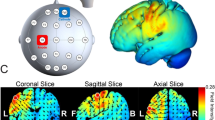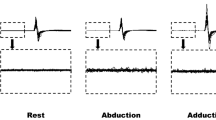Abstract
It is well established that the presence of external feedback, also termed augmented feedback, can be used to improve performance of a motor task. The present study aimed to elucidate whether differential interpretation of the external feedback signal influences the time to task failure of a sustained submaximal contraction and modulates motor cortical activity. In Experiment 1, subjects had to maintain a submaximal contraction (30 % of maximum force) performed with their thumb and index finger. Half of the tested subjects were always provided with feedback about joint position (pF-group), whereas the other half of the subjects were always provided with feedback about force (fF-group). Subjects in the pF-group were led to belief in half of their trials that they would receive feedback about the applied force, and subjects in the fF-group to receive feedback about the position. In both groups (fF and pF), the time to task failure was increased when subjects thought to receive feedback about the force. In Experiment 2, subthreshold transcranial magnetic stimulation was applied over the right motor cortex and revealed an increased motor cortical activity when subjects thought to receive feedback about the joint position. The results showed that the interpretation of feedback influences motor behavior and alters motor cortical activity. The current results support previous studies suggesting a distinct neural control of force and position.



Similar content being viewed by others
References
Allen TJ, Ansems GE, Proske U (2007) Effects of muscle conditioning on position sense at the human forearm during loading or fatigue of elbow flexors and the role of the sense of effort. J Physiol 580:423–434
Boisgontier MB, Nougier V (2013) Proprioception: bilateral inputs first. Neurosci Let 534:96–100
Davey NJ, Romaiguere P, Maskill DW, Ellaway PH (1994) Suppression of voluntary motor activity revealed using transcranial magnetic stimulation of the motor cortex in man. J Physiol 477(2):223–235
Di Lazzaro V, Oliviero DRA, Ferrara PPL, Mazzone AIP, Rothwell PTJC (1998) Magnetic transcranial stimulation at intensities below active motor threshold activates intracortical inhibitory circuits. Exp Brain Res 119(2):265–268
Enoka RM, Baudry S, Rudroff T, Farina D, Klass M, Duchateau J (2011) Unraveling the neurophysiology of muscle fatigue. J Electromyogr Kinesiol 21:208–219
Hopper D (2003) The influence of visual feedback on power during leg press on elite women field hockey players. Physical Therapy in Sport 4:182–186
Klass M, Lévénez M, Enoka RM, Duchateau J, Le M (2008) Spinal mechanisms contribute to differences in the time to failure of submaximal fatiguing contractions performed with different loads. J Neurophysiol 99(3):1096–1104
Langhorne P, Coupar F, Pollock A (2009) Motor recovery after stroke: a systematic review. Lancet Neurol 8:741–754
Lauber B, Leukel C, Gollhofer A, Taube W (2012) Time to task failure and motor cortical activity depend on the type of feedback in visuomotor tasks. PLoS ONE 7:e32433
Löscher WN, Nordlund MM (2002) Central fatigue and motor cortical excitability during repeated shortening and lengthening actions. Muscle Nerve 25:864–872
Milner TE, Hinder MR (2006) Position information but not force information is used in adapting to changes in environmental dynamics. J Neurophysiol 96:526–534
Moran K, Murphy C, Marshall B (2011) The need and benefit of augmented feedback on service speed in tennis. Med Sci Sports Exerc 44(4):754–760
Oldfield RC (1971) The assessment and analysis of handedness: the Edinburgh inventory. Neuropsychologia 9:97–113
Peacock B, Westers T, Walsh S, Nicholson K (1981) Feedback and maximum voluntary contraction. Ergonomics 24:223–228
Petersen NC, Butler J, Marchand-pauvert V, Fisher R, Ledebt A, Pyndt HS, Hansen NL, Nielsen JB (2001) Suppression of EMG activity by transcranial magnetic stimulation in human subjects during walking. J Physiol 537(2):651–656
Petersen NC, Butler J, Taylor JL, Gandevia SC (2010) Probing the corticospinal link between the motor cortex and motoneurones: some neglected aspects of human motor cortical function. Acta Physiol 198:403–416
Porter R, Lemon RN (1993) Corticospinal function and voluntary movement. Oxford University Press, Oxford
Rudroff T, Justice JN, Matthews S, Zuo R, Enoka RM (2010) Muscle activity differs with load compliance during fatiguing contractions with the knee extensor muscles. Exp Brain Res 203:307–316
Schmidt RA, Lee T (2011) Augmented Feedback. In: Schmidt RA, Lee T (eds) Motor control and learning—a behavioral emphasis. Human Kinetics, Champaign, pp 393–427
Scott SH (2003) The role of primary motor cortex in goal-directed movements: insights from neurophysiological studies on non-human primates. Curr Opin Neurobiol 13:671–677
Seifert T, Petersen NC (2010) Changes in presumed motor cortical activity during fatiguing muscle contraction in humans. Acta Physiol 199:317–325
Vuillerme N, Boisgontier M (2008) Muscle fatigue degrades force sense at the ankle joint. Gait & posture 28:521–524
Zuur AT, Lundbye-jensen J, Leukel C, Taube W, Grey MJ, Gollhofer A, Nielsen JB, Gruber M (2010) Contribution of afferent feedback and descending drive to human hopping. J Physiol 5:799–807
Author information
Authors and Affiliations
Corresponding author
Rights and permissions
About this article
Cite this article
Lauber, B., Keller, M., Leukel, C. et al. Specific interpretation of augmented feedback changes motor performance and cortical processing. Exp Brain Res 227, 31–41 (2013). https://doi.org/10.1007/s00221-013-3482-8
Received:
Accepted:
Published:
Issue Date:
DOI: https://doi.org/10.1007/s00221-013-3482-8




